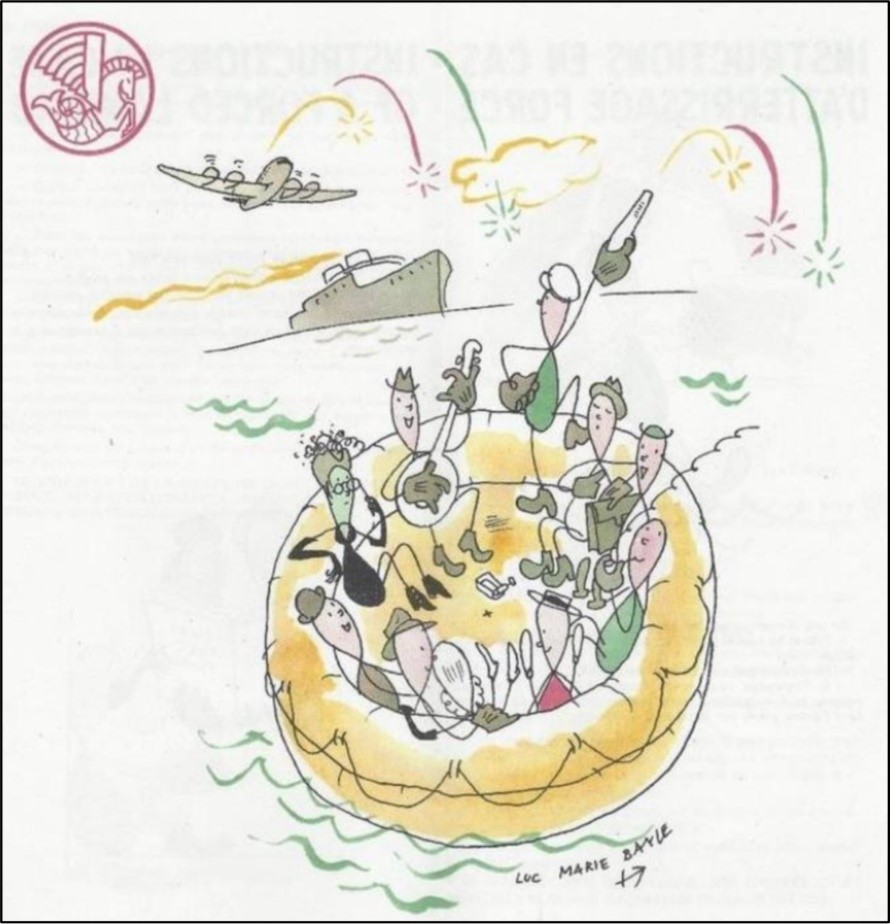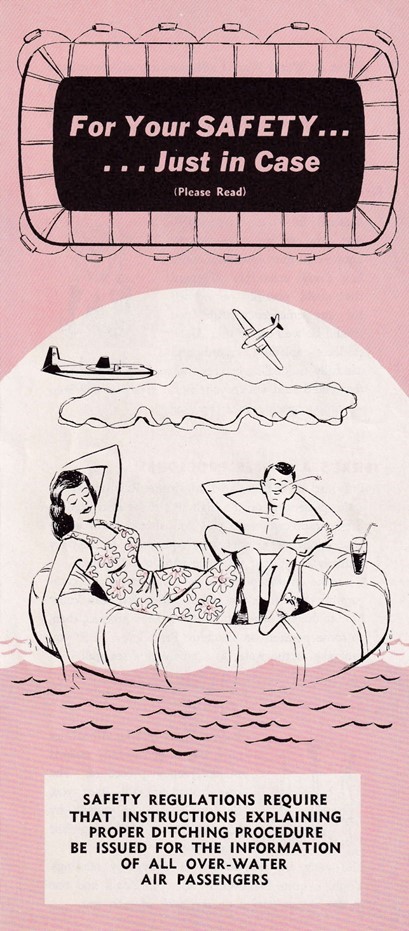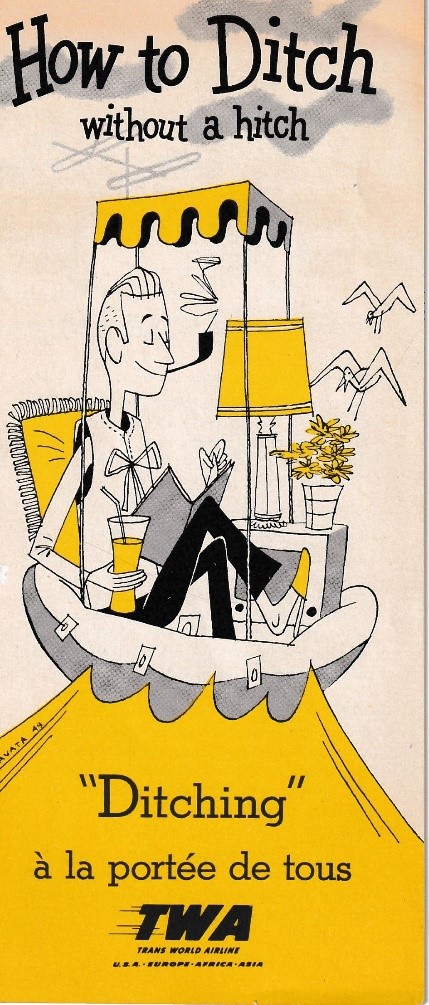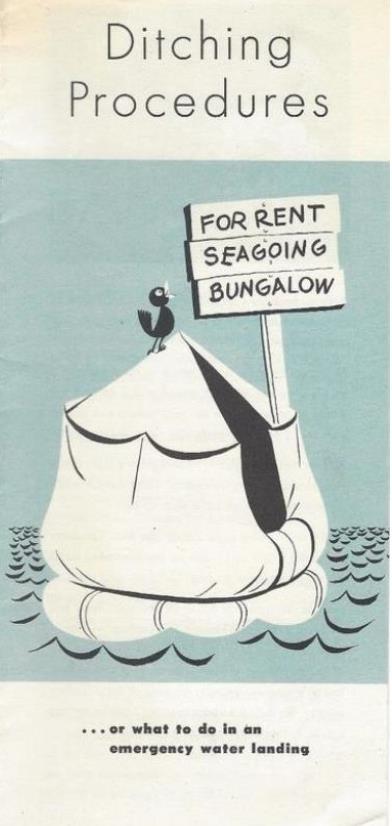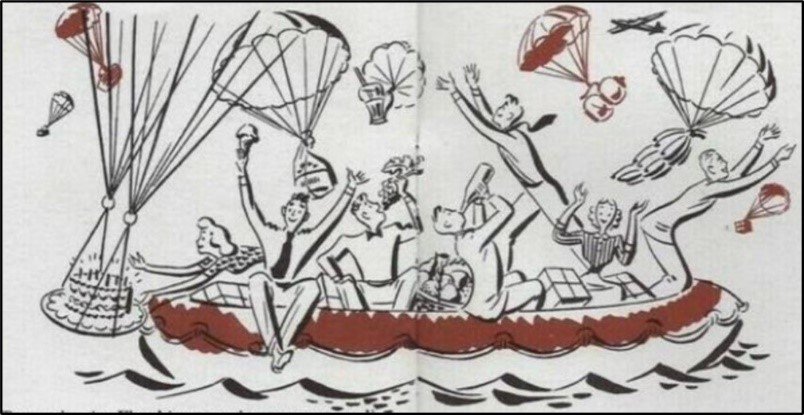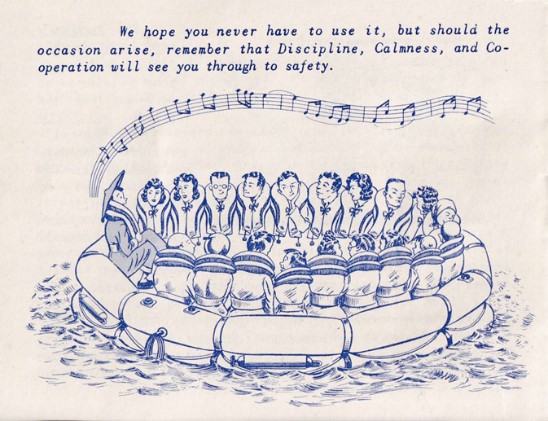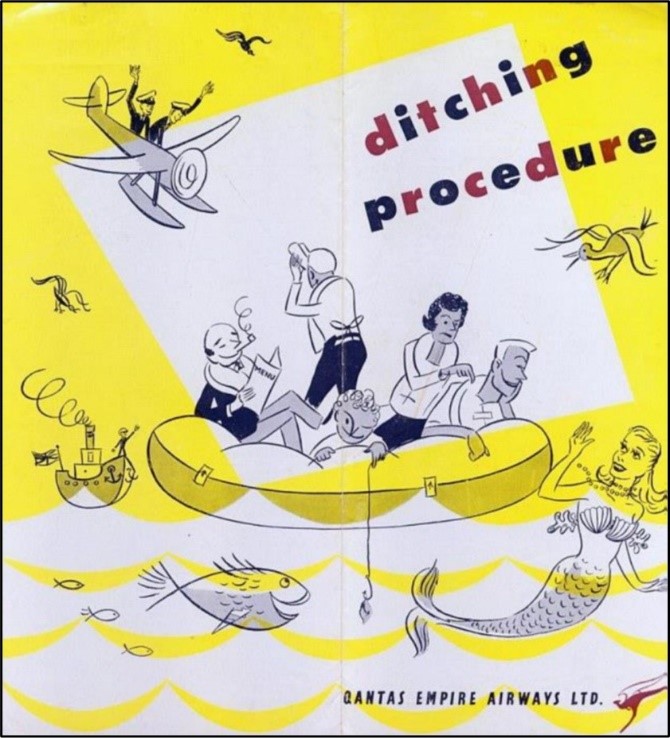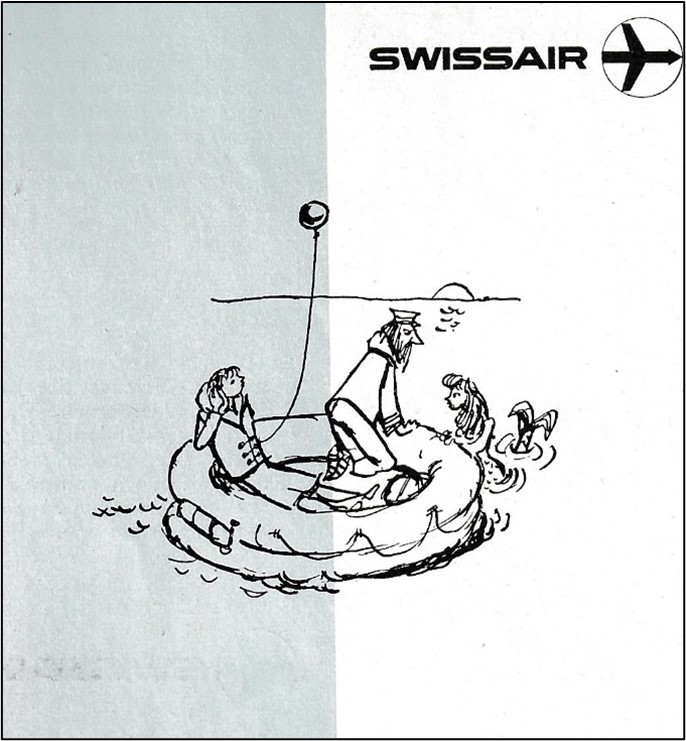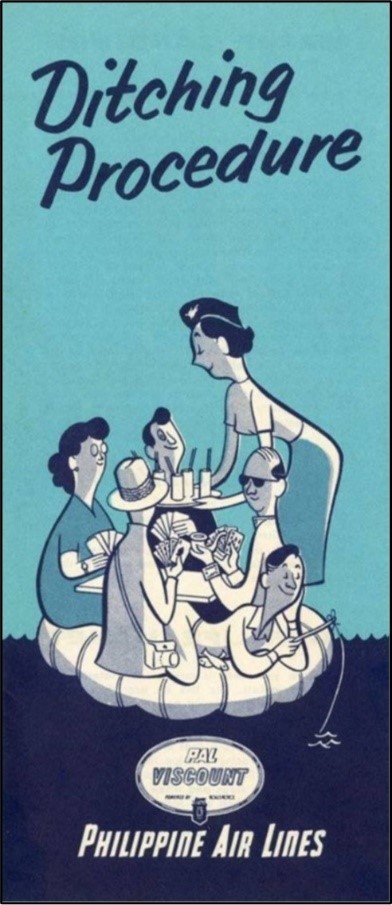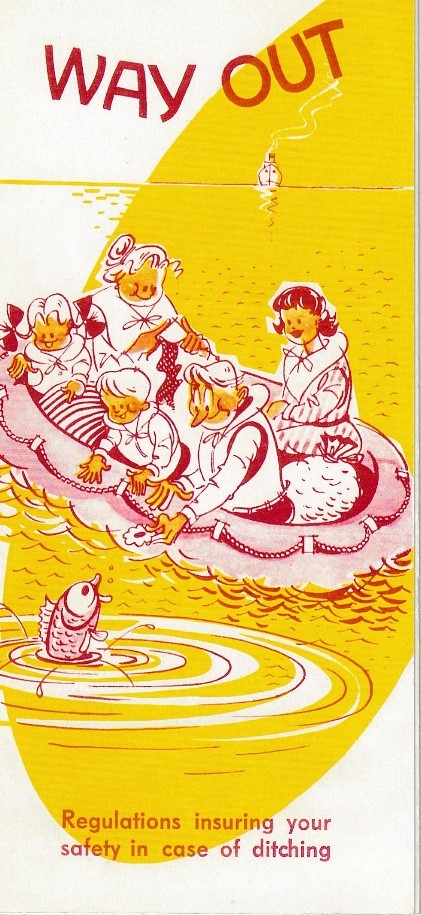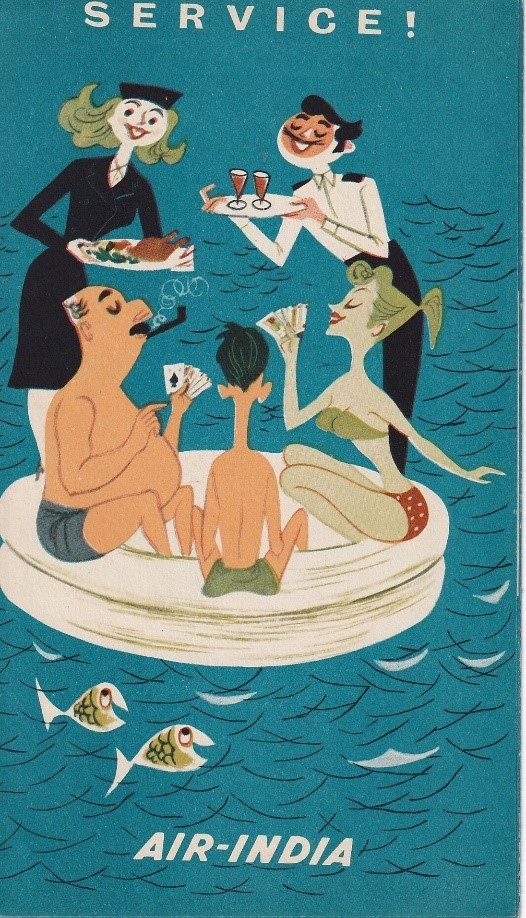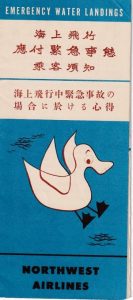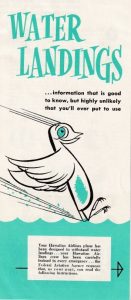Air France,American Overseas Airlines,BOAC,Ditching,Egress,Northwest Airlines,Pan American,Panagra,PAWA,Safety cards,Safety first,Safety leaflet,TWA
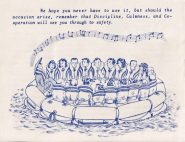
History of Safety Cards, Part 2: The Ditching Decade
By Fons Schaefers
Trammel Again
World War Two confirmed the United States (US) as the leader of world civil aviation. The war, which started in Europe and lasted the longest there, caused the European players to lose the dominant position they had gained in the pioneer years of the 1920s and 1930s. In the United States, civil aviation could develop fairly uninterrupted. The Douglas DC-3 became the norm in air travel from 1936 onwards and throughout the war years. It solidified the dominant position that the United States, by now, had reached in civil aviation not only in terms of technology and traffic volume but, also in terms of safety regulatory standards. A position that it has kept ever since.
In the first part of this series, we saw the very first signs of what we now know as cabin safety. An improvement in exit marking and lighting was made in response to the 1943 Trammel accident, but there was also the issue of the exit handles not being apparent to passengers. Coming back to the question about the first safety card in the US, it was brought to my attention that two airlines introduced specific printed instructions to passengers. Presumably, they were inspired by Trammel.
United Airlines added to its flight information folder an item on the location of the control of the ‘auxiliary exits’ in their DC-3s.
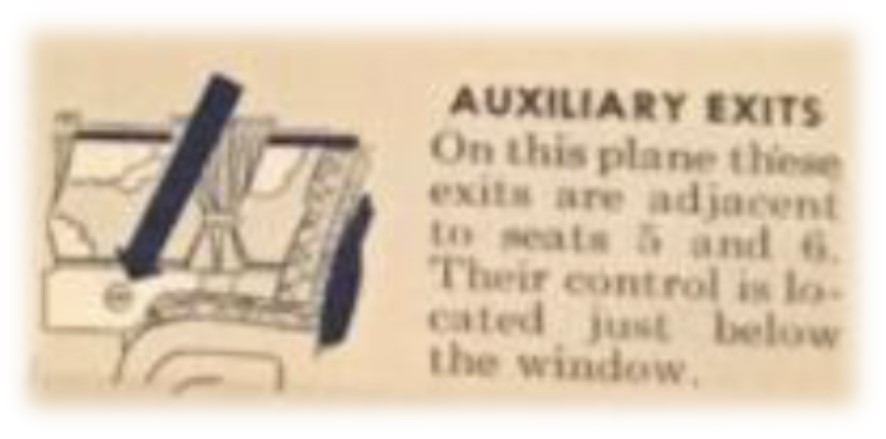
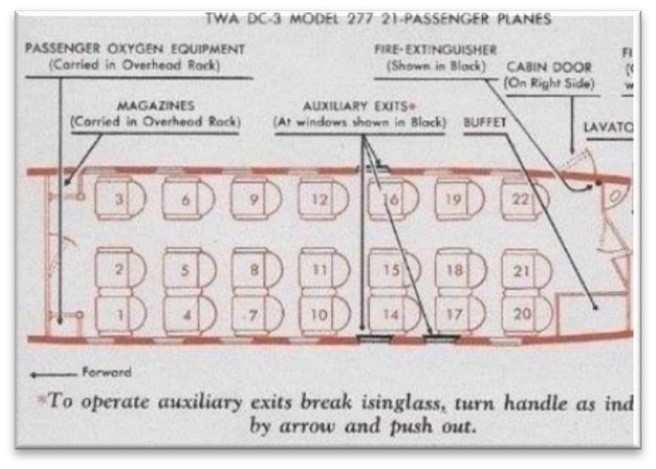
TWA went a step further and added in its “Welcome aboard” folder detailed cabin diagrams of the three DC-3 versions in their fleet indicating exits and equipment. I reproduce the model 277 which has the cabin door at the RH rear side. Instructions for operating the three auxiliary exits are given below the diagram. No instructions were given for opening the main door, however.
While not being true safety cards, these two publications can certainly be seen as forerunners.
Ditching Safety Leaflets
Proper leaflets dedicated entirely to passenger safety followed in the year immediately after the end of the war. Their subject invariably was passenger preparation for ditching. I am aware of leaflets first issued by Pan American World Airways (PAWA), American Overseas Airlines (AOA) and BOAC in 1946, Air France in 1947, SAS[1] and United Airlines in 1948 and TWA and Panagra in 1949. More airlines would follow in the 1950s, as we will see later. Here are some front pages. AOA was the international arm of American Airlines. It flew to Ireland, the UK, the Netherlands, Scandinavia and West Germany. The three languages (English, Dutch and Swedish) represent these countries, except for Germany. It may well be that the volume of German passengers in those years was too low to merit the extra translation. AOA was bought by PAWA in 1950. PAWA’s leaflet shown is the 1947 issue.
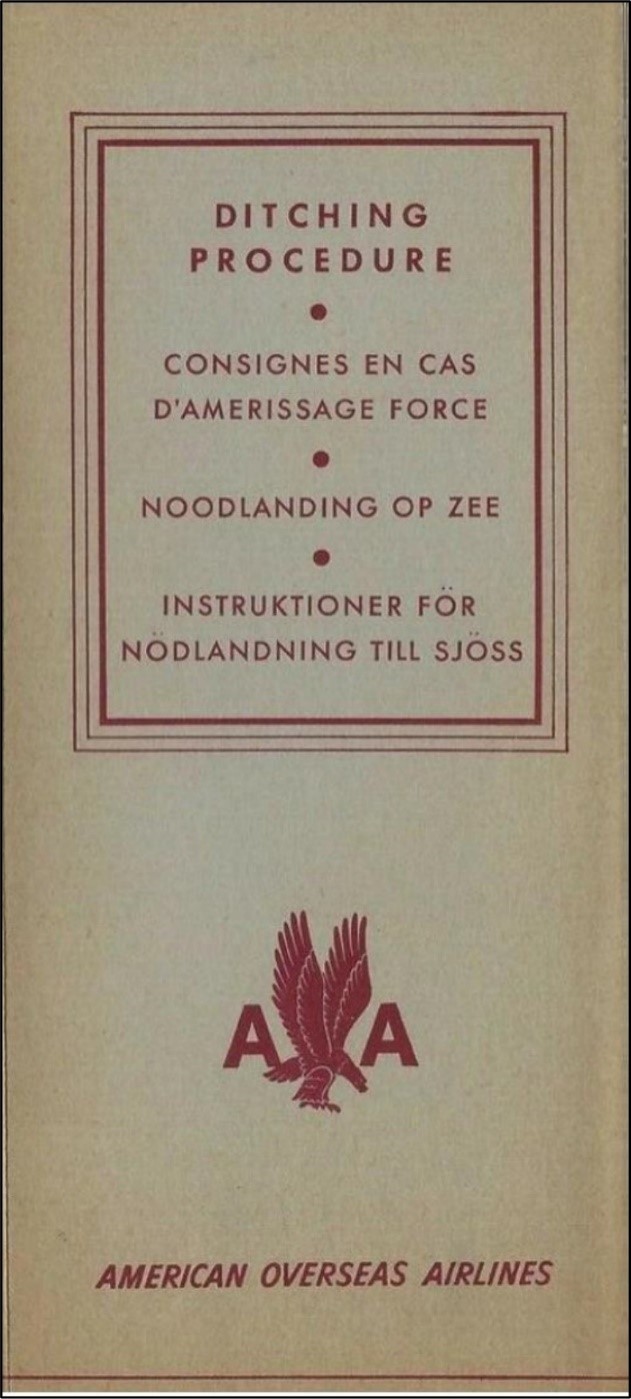
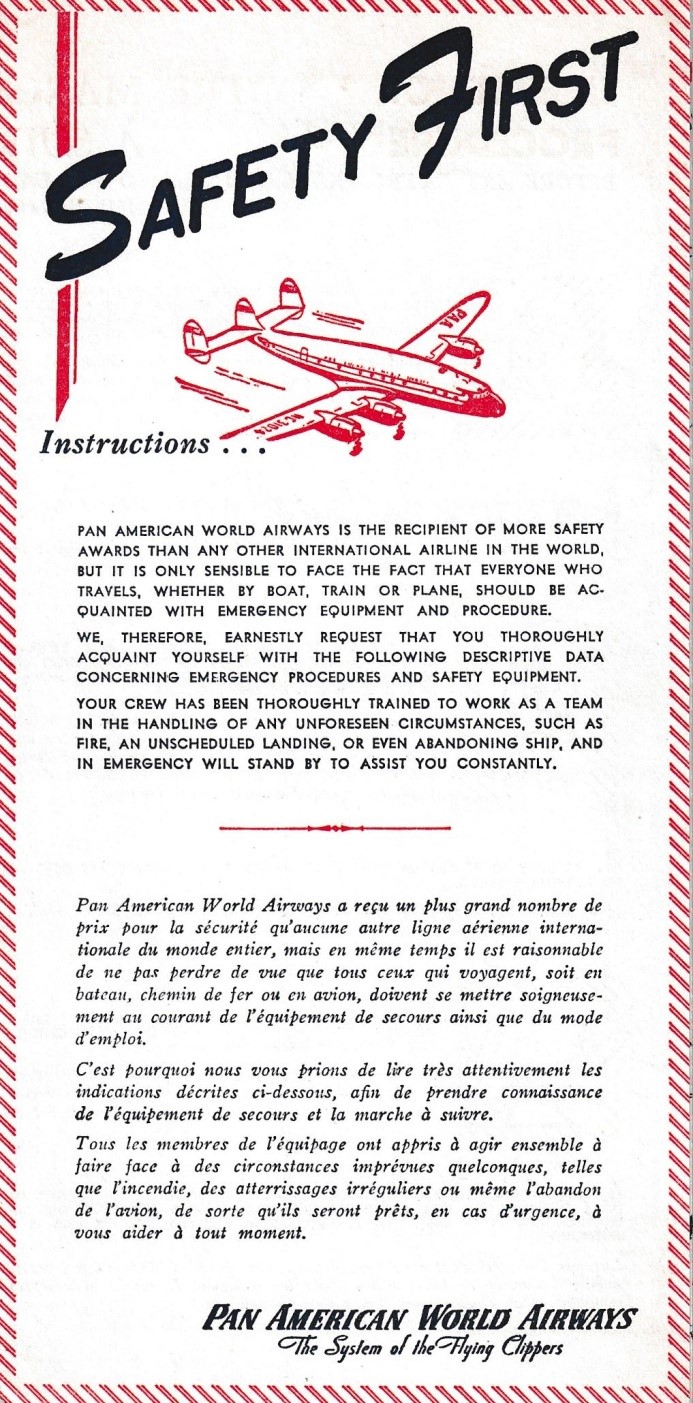
[1]SAS called their ditching leaflets ‘Safety at Sea’ so as to alliterate with their own name.
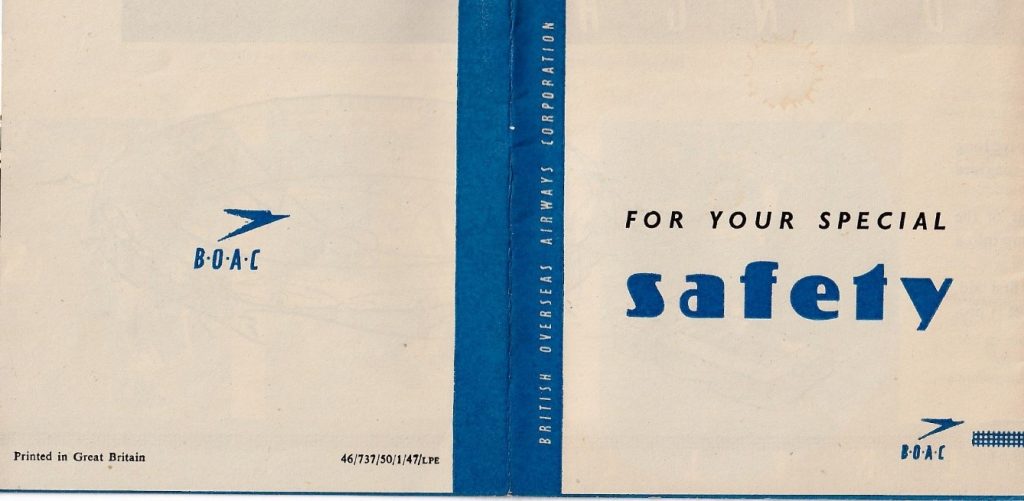
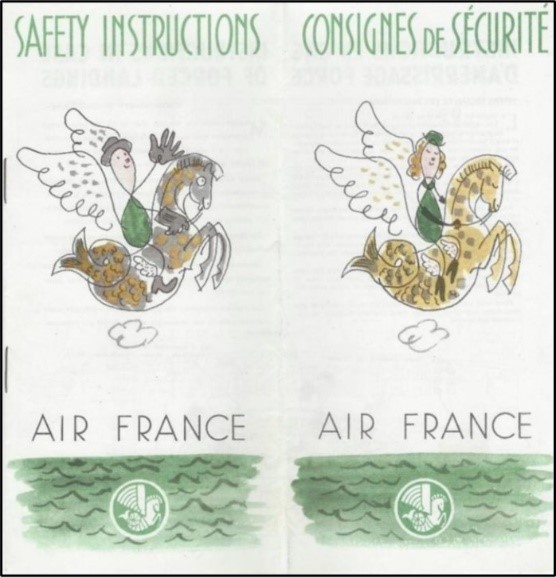
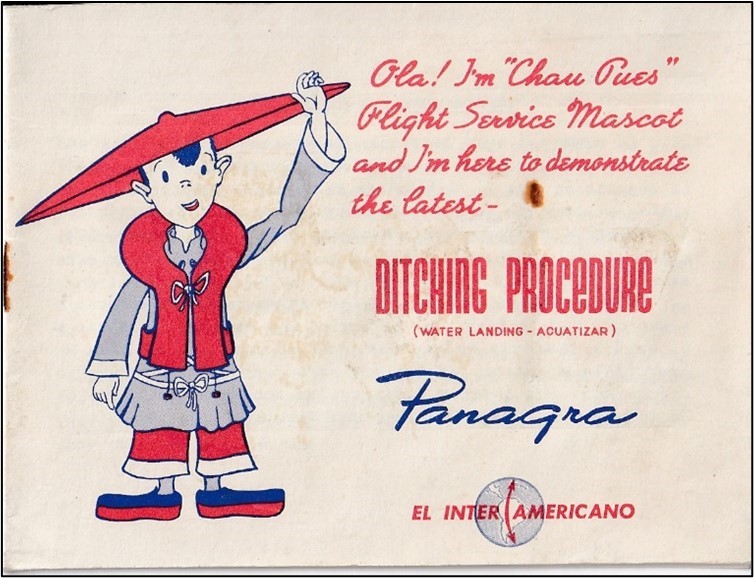
What caused this surge of safety leaflets and why were they all about ditching? The answer is threefold.
Still fresh in contemporary minds was a notable water accident that occurred just before the war. On its way from New York to Bermuda on January 21, 1939, an Imperial Airways Short Empire flying boat named Cavalier had to make a forced landing halfway along its oceanic journey. It broke up upon impact and sank shortly after. All 13 occupants had survived the impact, but three drowned. The flying boat had no life rafts on board and, for that matter, neither did it have seat belts. The only life-saving equipment on board was 22 ‘seat-type’ and six ‘crew-type’ ‘rubber life belts’ (life vests)[1]. Of these 28 life vests only eight were used, four of each. The survivors clung to them for 10 hours in the water, which was moderately warm, before rescue came. The British Air Ministry Inspector of Accidents made a list of recommendations for safety improvements on flying boats, including life rafts as standard equipment and instructing passengers on the fastening of seat belts on take-off and landings, the pointing out of emergency exits and how to fasten life-belts. It was noted that ‘an illustrated notice showing how life-belts should be put on was displayed in each cabin of the flying boat. This, I assume was a fixed message similar to those carried on ferry boats.
[1]Press summary of Report of the Investigation of the Accident to the Imperial Airways aircraft G-ADUU (Cavalier) on January 21, 1939, Office of the Air Attaché British Embassy, Washington D.C., March 25, 1939.
During the war considerable experience had been gained with transoceanic flying, albeit with military transport aircraft. In about 1 per 1,000 crossings[1] they had to make a water landing on the ocean, which became known as a ‘ditching’. The survivability rate was about 30%. This experience, together with that of Cavalier, may well have inspired the US Civil Aeronautics Board (CAB) to issue a regulation for increasing the chances of surviving a ditching:
‘The crew of aircraft used in overwater flights shall be drilled periodically in “abandon ship” procedures. Passengers shall be acquainted with the location of emergency exits, with emergency equipment provided for individual use, and with the procedure to be followed in the case of an emergency landing on the water.’[2]
This regulation, which was part of a whole set of new regulations, applied from September 1945 but only to U.S. carriers flying ‘outside the continental limits of the United States.’ At the time, they were only PAWA, AOA and TWA. In 1947 they were joined by United Airlines which started to fly to Hawaii and Northwest Airlines which connected the US with Japan and China.
[1]Human Factors in Air Transport Design, Ross A. McFarland, 1946, p. 534
[2]U.S. Civil Air Regulations, 41.507 Use of emergency equipment, effective September 1, 1945
Thirdly, the Search and Rescue (SAR) division of the then still provisional International Civil Aviation Organization issued in December 1946 recommendations for the briefing of passengers: before take-off, on the use of safety belts and the location of emergency exits; after take-off, on life jackets and other emergency equipment. In the case of an in-flight emergency, passengers should be further briefed in anticipation of an impact that, more likely than not, would be on water.
Thus, the focus of the new requirement and recommendations for briefing passengers was on overwater flights and an emergency landing on water. There was no equivalent requirement for an emergency landing on land. Why not? To answer that question, we have to study accidents of the time. They typically occurred during the cruise portion of a flight. Even in the cases where the aircraft remained controllable, impact landings on land tended to be fatal to all. The 1943 Trammel case had been an exception, but only partial, with two survivors out of 20 occupants. The Cavalier accident and the military services however had demonstrated that a ditching could be well survivable.
So, now that the war was over and commercial air transport was to grow in size and span oceans, a ditching was recognized as the principal survivable accident scenario. They were therefore prone to regulatory support. The form chosen was to mandate that airlines ‘acquaint with’ or brief passengers about ditching procedures. Nowhere were leaflets or booklets mandated, but airlines found they served the purpose.
A Closer Look
Studying these instructions and keeping in mind current practices, a number of differences in tone and directions stand out. The key message was that of aviation being safe, the crew having been thoroughly trained and always in control in which its authority was never to be questioned (see PAWA illustrations above and below).
A ditching, it was believed at the time, would not come sudden but announced, with plenty of time to prepare for it. On the part of passengers, that meant loosening the tie, removing sharp objects, taking off spectacles and high-heeled shoes, putting on warm clothes and then a life vest, sit tightly strapped in and, when so ordered, brace for impact. There was no common opinion on what to do with seatbacks: some airlines said upright, others said recline as much as possible. For some airlines, the brace position for forward row passengers was to sit on the floor with the back against a bulkhead (see illustration Air France 1953).
Opening exits, if even mentioned at all, was to be left to the crew. The American airlines typically added a layout of the aircraft with exit and raft locations, while in Europe this was less common. PAWA included a detailed graph of the life raft and the survival pack contents on their leaflets (see illustration below).
PAWA and BOAC issued new versions of their safety leaflets almost every year. United, TWA and Northwest, on the other hand, stuck to their original designs for at least a decade, only changing them to match fleet updates. For the other airlines, changes were more random.
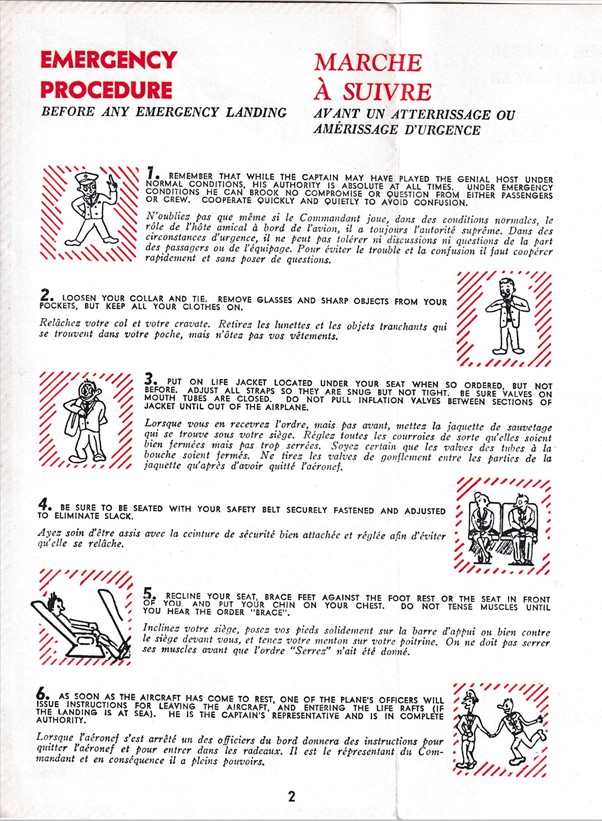
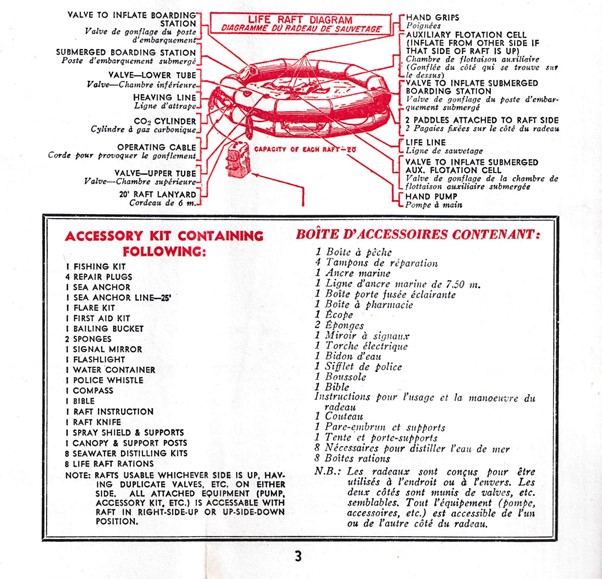
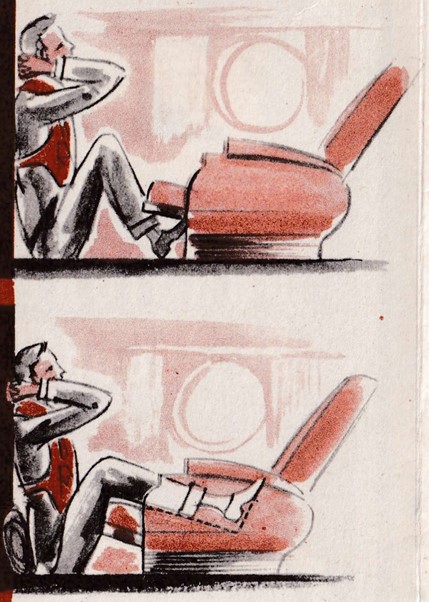
BOAC’s 1946 folder explained life jackets and rafts, called ‘dinghies,’ but did not have a layout of the aircraft, nor any explanation about where the exits were or how they opened. Yet, seat belts were explained. Contrary to the Americans, who only advised the use of seat belts in preparation for an emergency landing, BOAC advised that the seat belts ‘should be fastened when the aircraft is taxiing[1], taking off or landing’. Clearly, that stemmed from the Cavalier accident recommendations.
[1]The addition of taxiing is particularly noteworthy as that was many decades ahead of becoming common practice in the rest of the world, except that SAS also had this in their safety instructions.
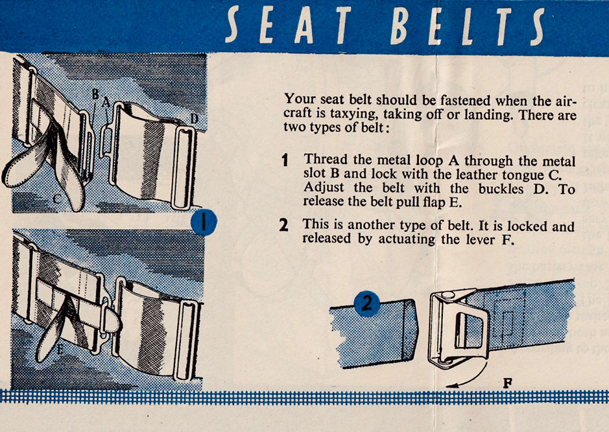
For aircraft not equipped with pressurized cabins, oxygen masks were explained by BOAC.
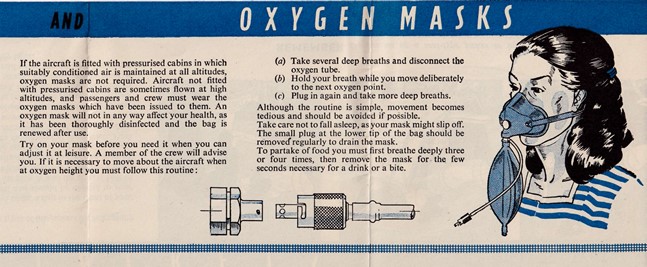
In the 1947 BOAC folder exits were mentioned for the first time, but not depicted. It said, “there are ample emergency exits on all Speedbirds which will be pointed out to you by a member of the crew before take-off.” Also added was a single text line about desert packs ‘containing rations and water’ being carried, as well as ‘very comprehensive First-Aid Packs.’ The portion about the oxygen mask now cautioned ‘please don’t confuse this with a gas mask. It does not have to fit tight.’ With the war still fresh in people’s minds, passengers apparently had made this comparison when reading the earlier version.
Aircraft Diagrams
The summum bonum of 1950s luxury flying was the Boeing 377 Stratocruiser. To give an impression of how cabin diagrams were rendered in safety leaflets, here are five of them, by as many different airlines, so you can compare. BOAC chose to only show the aircraft from outside, with the exits marked with arrows. Conversely Northwest did not point out any exit, but only emergency equipment, using an engineering drawing of the cabin. Yet, on a closer look, the escape ropes gave a hint as to where exits were, at least for those not over the wings. Over-wing exits needed no ropes. The other three airlines also used cabin plans, all in their own fashion, showing both the exits and emergency equipment. They were oriented with the front of the aircraft at the top, matching the compass of a forward-facing passenger. All Stratocruisers had the lower lobe lounge, but only one airline, PAWA, marked its exits, plus that of the storage area ahead of the wings. There are many other interesting features in these layouts such as the spacious, gender-specific washrooms. They are clearly identified in the AOA layout and can also be recognized in the United and Northwest samples.
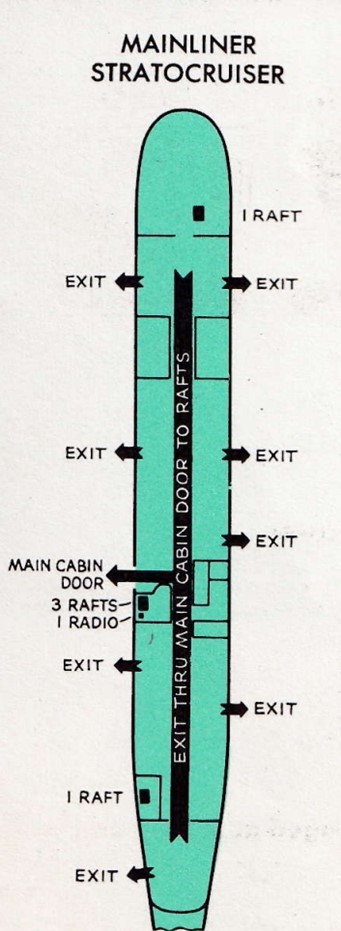
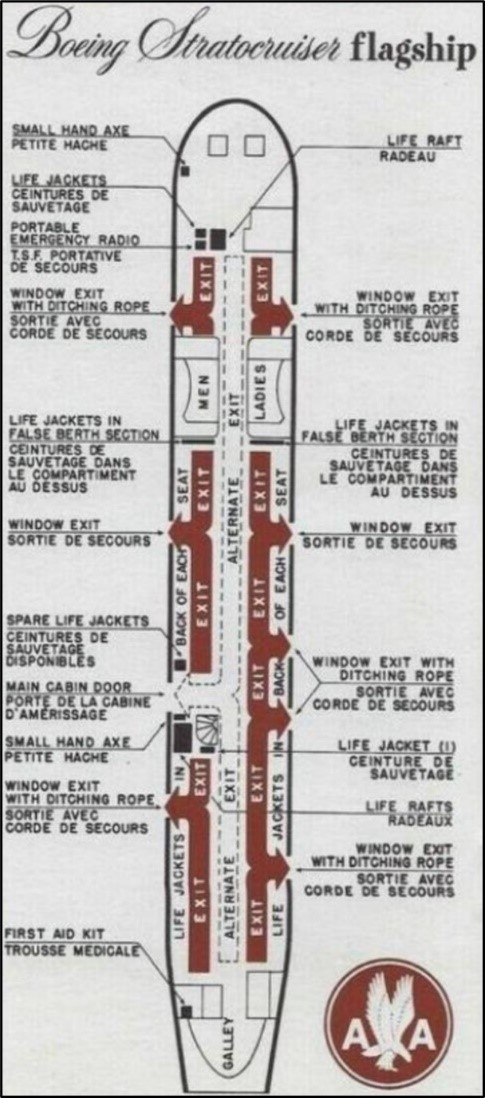
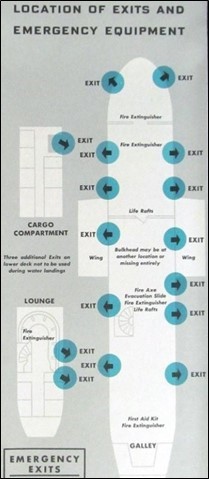
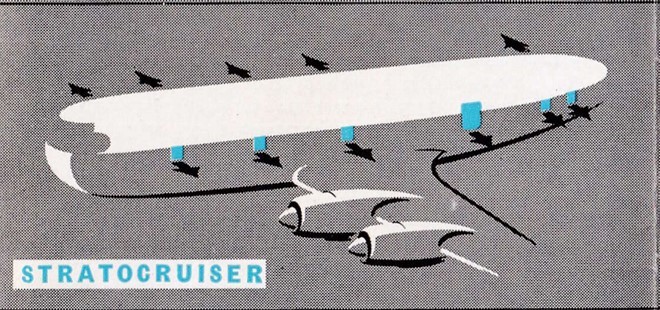
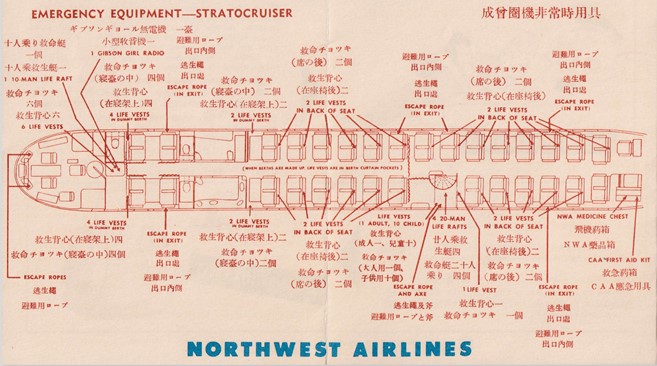
Cozy Rafts and Duck Landings
The texts in the safety leaflets were light-hearted so as not to put off passengers by emphasizing the dangers of flying. Phrases were used like:
‘life vests are fashionable in emergency landings. Yours is bright yellow and quite handsomely tailored’
and
‘Brace for impact – careful the order is not embrace!’
Similarly, entertaining cartoons were used, often showing a life raft as a cozy place to be. Here is a collection. Click on each image to enlarge.
Other airlines preferred the analogy to ducks. Shown are Northwest, 1952, and Hawaiian, 1963.
Ditching experience
So, with all the focus on ditching, did they indeed occur, and were life rafts lifesavers? The first recorded use of a life raft, ironically, was not on water, but in a desert, giving shade and shelter. That was following the crash on June 18, 1947 of Clipper Eclipse, a PAWA Lockheed Constellation, in Syria. Star Trek aficionados will likely know this accident. Its creator, Eugene Roddenberry, was the third officer and took a leading role as the two pilots were killed upon impact. In this crash, out of 37 occupants, 22 survived and were rescued.
The first reported ditching was in 1949. Until about 1963, on average one ditching occurred per year, worldwide, making the 1950s the ditching decade. In all cases, it involved piston-engine airliners. Other than as initially predicted and thus advertised in the safety instructions, most were sudden with no time for preparation. On the positive side, many were close to shore rather than mid-ocean, facilitating quick rescue. The survival rate was high; in some cases even 100%.
A new accident scenario
But another accident scenario quickly overtook that of the ditching in terms of numbers and survivability issues and, thus, the need for cabin safety measures. That scenario is the survivable accident involving a fire, at or near an airport.
It first happened three weeks before the Syrian crash, on May 29, 1947. United Airlines flight 521, a DC-4, failed to lift off at New York-La Guardia. It crossed the airport perimeter and half bounced, half flew until it came to rest 800 ft beyond the runway. It caught fire immediately and many occupants perished as they were unable to escape. In a congressional hearing in February 1950, it was testified that ‘passengers were seen by witnesses drumming on the inside of cabin windows, burning to death.’[1] The formal accident investigation by the CAB did not go into any of the survivability issues. Its report, issued after many preventive measures had been taken, concluded that ‘all action that it seems sensible to take has already been taken’. In hindsight, this was quite a cynical comment, as no cabin safety measure had been taken at all, let alone even considered. It needed a second accident before the CAB realized that their focus should not only be on preventing accidents to happen in the first place, but also when they do occur, on survivability issues. In their report on the January 21, 1948, Eastern Constellation crash at Boston they said that ‘this accident forcibly points to the necessity for the development of more suitable passenger evacuation facilities’. In that accident, some passengers survived but, had to jump a distance of more than 15 feet from the airplane to the ground.
[1]Hearings before a subcommittee of the (U.S. Congress House) committee on interstate and foreign commerce, February 14, 1950.
Many similar accidents would follow and in numbers and dramatic impact soon eclipsed the forced ditchings. From two different angles, scientists recognized this serious trend and started tests to collect data to understand the mechanisms of fire spread and airliner evacuation respectively. The Medical Division of the Office of Aviation Safety of the US Civil Aeronautics Administration (now FAA Civil Aerospace Medical Institute) organized evacuation studies and live tests in 1951 and 1952, jointly with the George Washington University, the US Air Force and three airlines: American Airlines, PAWA and TWA. This gave insight into the limitations imposed by exit sizes, sill-to-ground distance and descent assist means as well as human performance and interaction during evacuations. A new regulatory formula was drafted for prescribing exit numbers, sizes and locations which in essence is still in use today.
In the same period, NACA (now NASA) conducted full-scale tests in which self-propelled Curtiss C-46 and Fairchild C-82 aircraft sped along a monorail into concrete obstacles to study fuel fire ignition and propagation patterns and their effect on survival time for occupants.
Although the two scientific programs were done in isolation from each other, their results were merged and ripened the idea of a maximum evacuation time. Even before that, already in December 1951, the CAB had proposed a 90-second evacuation time limit but, this met with resistance from operators. The scientific evidence, aggravated by many more accidents, was needed to overcome that. Eventually, more than one and a half-decade later, a firm evacuation demonstration time limit was introduced, with conditions tighter than those proposed in 1951. More about this in a later part.
The airlines did not pick up the new accident trend as quickly. Rather, over the decade more airlines issued ditching safety instructions. In North America, these were Braniff, Canadian Pacific, Delta Air Lines, Eastern Airlines and Trans-Canada Airlines. In Europe, Iberia (Spain), LAI (Italy), KLM (Netherlands), Olympic Airways (Greece), Sabena (Belgium) and TAI (France). In the rest of the world such major airlines as Avianca (Colombia), Cathay Pacific Airways (Hong Kong), Civil Air Transport (Taiwan), JAL (Japan) and TACA (El Salvador) educated their passengers on ditching preparations.
Three front pages of typical 1950s ditching leaflets are reproduced: Iberia, Eastern Air Lines and KLM.
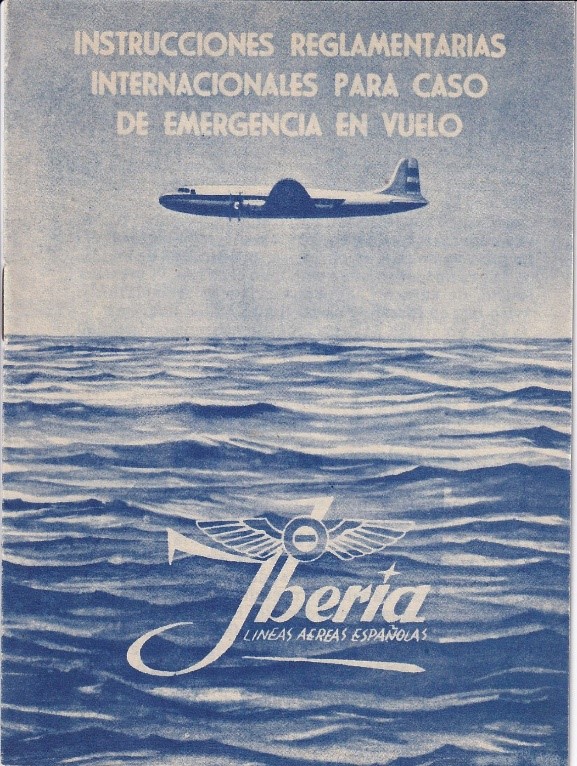
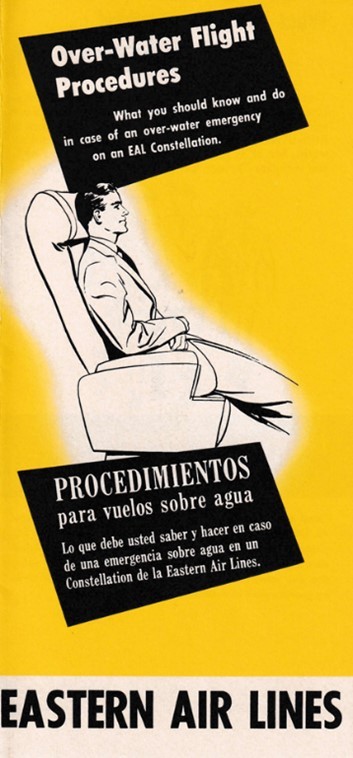
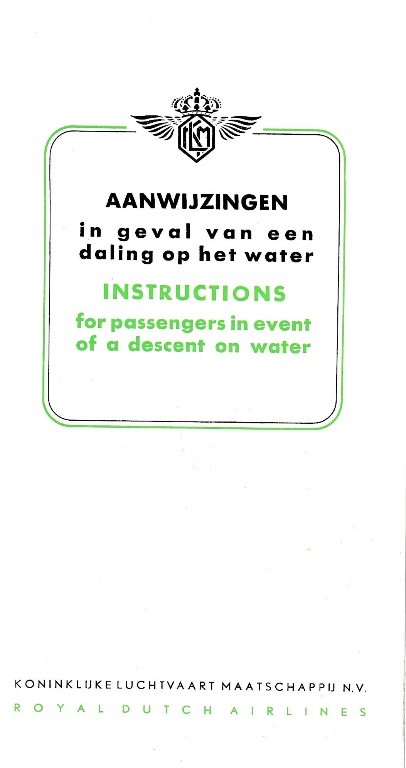
United’s egress
There was one airline that did recognize at an early stage the land evacuation scenario as serious and dedicated a safety leaflet to it. Not surprisingly, this was United Airlines, the airline of the 1947 La Guardia accident. Its president since 1934, William Patterson was known to care about the happiness and welfare of others and, like others, must have been deeply touched by that accident. From a 1981 biography: ‘Concern for safety had always been a major deterrent to airline travel, and improved safety was one of “Pat” Patterson’s major goals. During his 36 years with United, he personally inspected close to 70 percent of United’s accidents in order to obtain a personal feel for the extent of loss and the hardships brought upon the persons involved[1].’
When the ‘coach’ class was introduced in 1952 under strict CAB regulations, this meant lower fares, which would reduce revenue. To compensate for that, aircraft passenger capacities had to be increased. US airlines were happy to do so, but one: United Airlines. Patterson used the ‘evacuation card’ (no pun intended) to try and reverse this trend which in his view was unsafe. He staged, with the help of Cornell Aeronautical Laboratory of Buffalo, New York, a series of full-scale evacuations of a 66-seat DC-4 (the normal seating on a United DC-4 was 44, so a 50% increase). Passengers were offered a scenic ride over Niagara Falls, then land back at Buffalo where a surprise evacuation was ordered. In one case, the aircraft actually did develop a major engine problem and reportedly landed at Syracuse![2] The results he would then use to try and convince the CAB that increasing capacities would be hazardous. This plan did not work out[3],[4]. Yet, possibly as a follow-on to those tests, United Airlines introduced in early 1953 a safety folder specific to the land evacuation scenario for its domestic, non-overwaterDC-4s and DC-6s. This leaflet, in style and appearance, was completely different from the ditching leaflet used for the overwater fleet. It was called ‘the egress’ and issued in both a yellow as well as a blue version. A later revision (c. 1956) is also known. Note that the main doors are equipped with an escape chute but others only have a rope.
[1]William A. Patterson of United Airlines, Richard E. Hattwick, Journal of Behavioral Economics, Volume 10, Issue 2, Winter 1981.
[2]transcript of Emergency Evacuation Technical Conference, Seattle, September 6, 1985, Volume IV, p. 622.
[3]Aviation Week December 8, 1952.
[4]Regulation of Air Coach Service Standards, Stanley Berge, Journal of Air Law and Commerce, Volume 20, Issue 1, 1953.
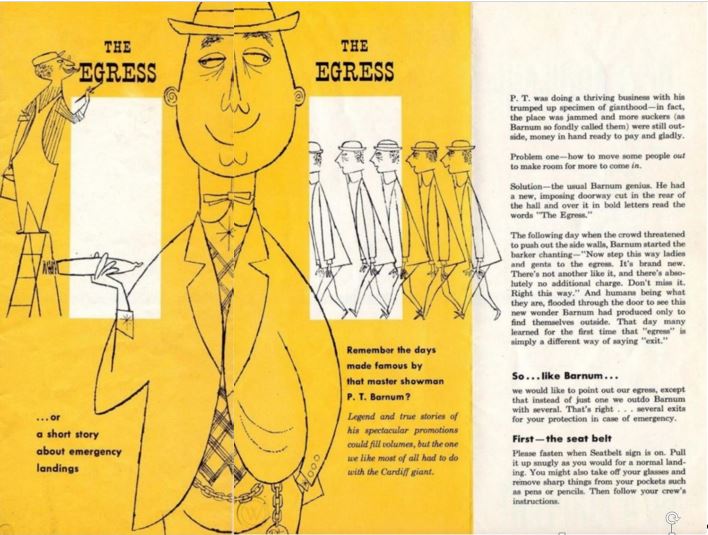
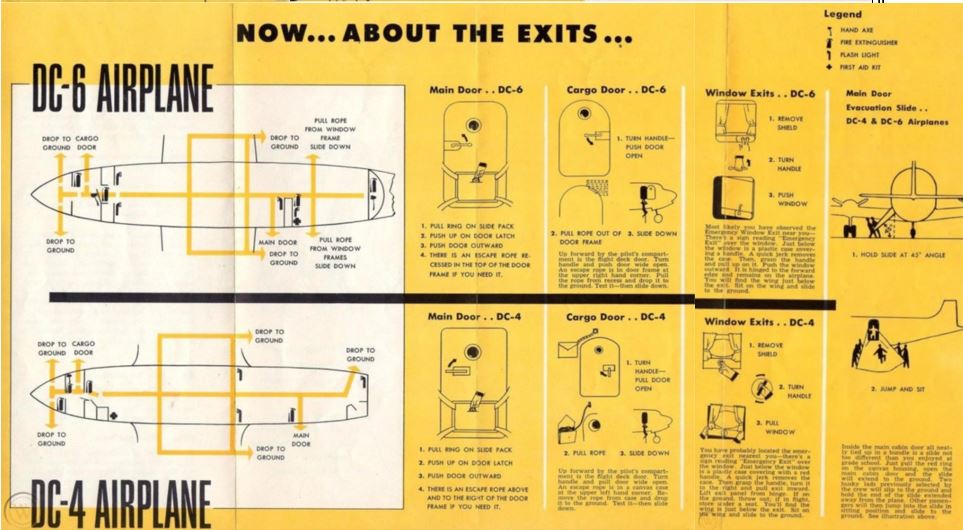
Chutes replace ropes
Towards the end of the decade airlines did add safety instructions for emergency landings on land in addition to, or instead of, those on water. At the same time, passengers were no longer briefed to wait for the crew to open exits, they were instructed how to open them themselves (see Sabena illustration below), or how to deploy and use escape chutes.
The chutes needed to be held taut by two ‘able bodied persons’ who had to jump down first. Still, they formed an improvement over the escape ropes and Jacob’s ladders that were the only descent assist means a few years before. A glance at the instructions for attaching floor straps to ensure that the chute would work will tell you that this would not be easy, especially for novices under stressful conditions. Yet, that was the state-of-the-art in 1957. Self-supporting, inflatable escape slides were about to be invented.
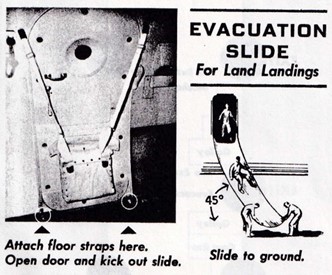
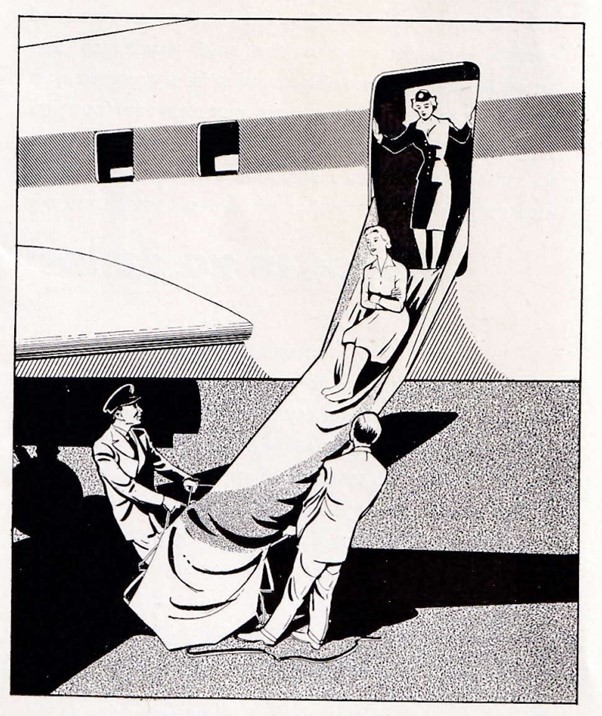
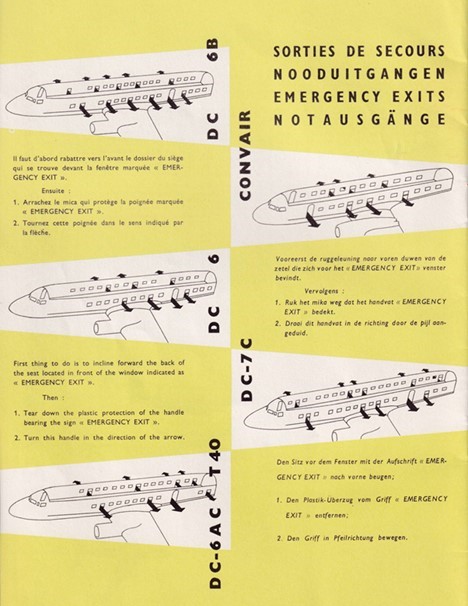
Souvenir
How were the safety leaflets circulated? The pre-war practice of issuing flight information packets (‘kits’) to passengers with a host of promotional material was continued well into the 1950s. In a pocketed folder were stacked such items as postcards, route maps, timetables, suggestion forms, stationary, destination brochures and even small dictionaries. Somewhere inconspicuously hidden in between was the safety folder. All was for the passenger to keep as a souvenir. No ‘do not remove from aircraft’ caveats yet. That would come later, as we will see in a future edition of this series. But before that we will look in the next edition what the beginning of the jet age meant for safety cards.
Illustrations reproduced from author’s collection, except for United and TWA 1943 and United ‘s ‘The Egress.’
March 2022
Email: f.schaefers@planet.nl
